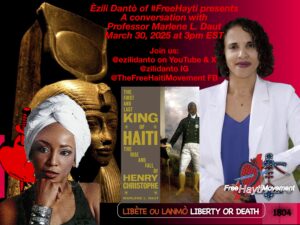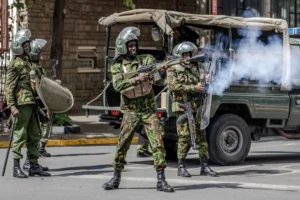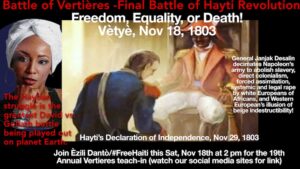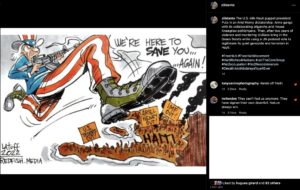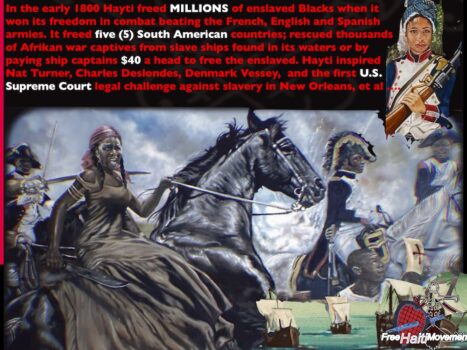
A #FreeHaiti revolution week post:
Today is August 22, 2022.
We mark the auspicious occasion that begin the Hayti Revolution, 231 years ago and declare, once again, Èzili’s Hayti continues to resist all tyrants, despots, colonists and invaders.
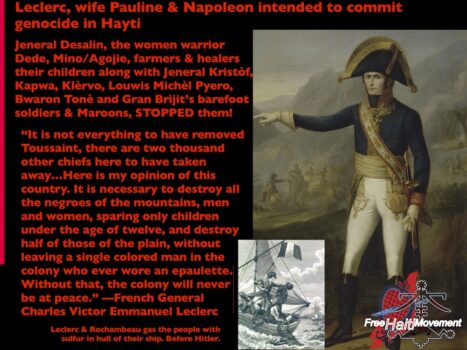
So much of our Afrikan Ancestor’s story has been distorted by establishment academics from the nations Hayti beat in combat and their schooled Haytians. They go around the bend to leave the world with the impression that in 1804 Hayti tyrants replaced the white tyrant-slaver-rapists who had held humans in bondage for 300years.
We, the descendants and inheritors of the Haytian Revolution resistance legacy, tell our own story. Bring attention to the millions who would be liberated because our Ancestors fought back the profit-over-people tyrants, their murderous Abrahamic male cults and white supremacist lies. Haytians are indeed the pioneers who invented human rights for the modern world and sparked off hundreds of thousand of minds and spirits to liberate themselves. Hayti helped avenge the Americas and sparked off the end of direct colonialism, chattel slavery and slowed down their “New World’s” overt, forced assimilation (“the whitening.”)
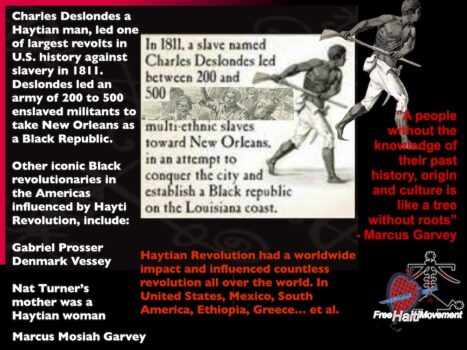
The Hayti District, a historic U.S. Black community that is now part of the city of Durham, North Carolina, is just one of the little known brilliant repercussions and influences of the Hayti Revolution. Hayti, the U.S. city, was founded as an independent Black community in the U.S. shortly after the American Civil War. To reMEMBER more, we provide, in addition to a photo essay showing historical facts little covered by mainstream academics, below 1) the historical facts about the Haytians of long ago Texas; 2) Desalin’s decree to liberate all enslaved Afrikans; 3) show how Hayti’s founding father offered $40 a head to all ship captains to bring captives (“their cargo”) to Hayti to be set free. And, 4) a letter from Hayti giving freedom to enslaved Jamaicans who rushed to Hayti for sanctuary and protection.
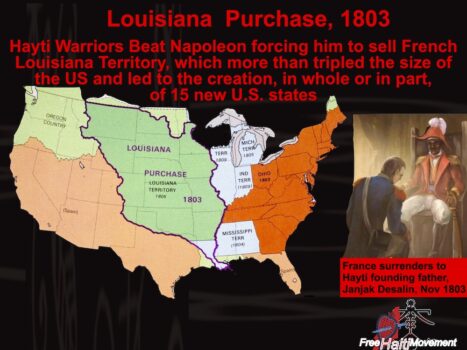
led to greater U.S. white settler power and racist expansion of the U.S. empire
***
On this 231th anniversary of the Hayti Revolution, #FreeHaiti remembers that our freedom was not charity given to us by any Breton-Woods UN-Euro organization, nor of a gift of any white men or women.
It was the blood of our Black Ancestors that flowed to set us free.
We #reMEMBER their sacrifices and the ways they left for us to follow to keep that freedom (Kanga Mundele, Kanga Bafyòti, Kanga Ndòki: No white may set foot on our lands as owner or proprietor).
We are the Èzili Dantò #FreeHaitiMovement! We reMEMBER (give our hands, feet, legs, arms, heart, mind, soul, energy to reanimate) General Moyiz, San Sousi, Sylla, Makaya, all the unknown bossal and Afrikan maroons. We lift up their courage and warriorship and, in their FORCE we stand, always choosing our peoples’ collective wellbeing (Viv, Lakou, Konbit, Jarden), before personal colonial salaries, titles and approvals.
Ayibobo, Awochenago e Bilolo pou Makandal, Grann Brijit, Zabèt, Boukman, Tousen, Mari-Sizann, Desalin, Enri Kristòf, Bwaron Tonè, Dede Defile, Dede Magrit, Adbaraya Toya, Gran Gitonn, Mari Jann, Mari Klè Erez, Sesil Fatiman, Mari Louwiz Kristòf, Sanit Belè, Jeneral Charles Bèlè, Jeneral Moyiz, San Souci, Makaya, Sylla, et al. Mèsi anpil e san fin – thank you without end!
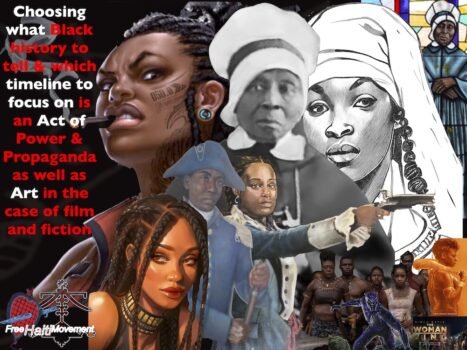
Hayti helped free many suffering peoples
Long absent from the pages of traditional Texas history books, the most forgotten and among the first anti-slavery fighting men in the annals of Texas history were Black Haytians. (See Twitter thread, here)
Yes, there was a time, before the white Colonists and invader tribes regrouped after the Hayti warriors beat them in combat (1791-1804), when the brave Black liberators of the Western Hemisphere were able to spread freedom to every shore in the Americas.
In those nearly 100-years of relative Haytian control, Hayti was the place boat people came to for asylum and rest from white horse patrol units like those you saw in Del Rio. See 2021 photo below showing Texas border patrol corralling suffering Haytians fleeing US-led colonial CoreGroup tyranny and their cholera democracy in Hayti.
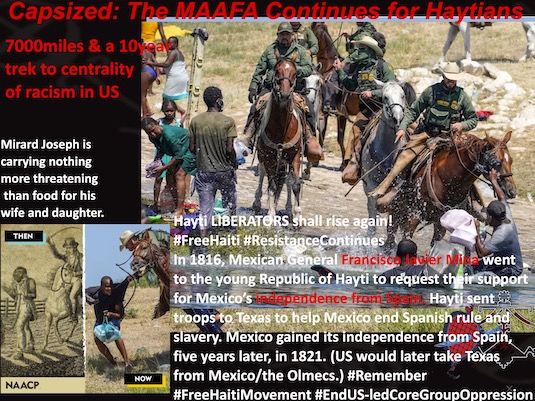
Del Rio Texas horrors, 2021
Haytian soldiers fought to end slavery in Mexico, 1816
Hayti LIBERATORS shall rise again!
In 1816, Mexican General Francisco Javier Mina went to the young Republic of Hayti to request their support for Mexico’s independence from Spain.
Hayti sent troops to Texas to help Mexico end Spanish rule and slavery. Mexico gained its independence from Spain, five years later, in 1821. (U.S. would later take Texas from Mexico/Olmecs.)
Hayti, A Sanctuary for the Oppressed. Land of the Free And the Brave
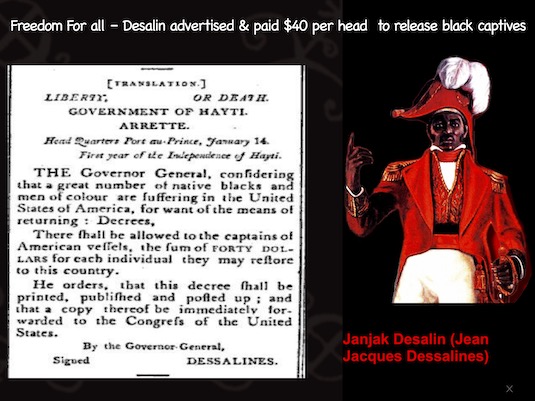
Desalin decree to liberate all enslaved Afrikans
After the creation of the Republic of Hayti, Janjak Desalin (General Jean-Jacques Dessalines), Hayti’s founding father, published a decree announcing his intention to devote part of the nation’s meager post-war budget to secure the freedom of enslaved human beings. Many United States slave-making ship captains collected the $40 payments that Desalin gave for the release of each enslaved person who set foot on Haytian soil.
Hayti founding father, Janjak Desalin, enshrined within the first Hayti Constitution in 1805, the most powerful, humane, and politically advanced provisions: any enslaved person of Afrikan descent who arrives on the shores of Hayti is automatically free and a citizen of Hayti; any person of another race who seeks asylum from tyranny from anywhere in the world would find asylum and safety in Hayti; all Haytians are known by the appellation “Black;” all whites who fought with Haytians during the revolution would also be known by the appellation “Black” and be citizens of Hayti.
After 300 years of European enslavement, the Afrikan warriors in Hayti did not make whites 3/5ths human. But said that the whites who fought for liberty alongside the Afrikan warriors are to receive full citizenship and the reward of being “Black,” meaning part of the ancient, pre-historic peoples whose actions show they are Lovers of Liberty and humane.
Here’s another spectacular example of Hayti generosity and compassion.

On January 30, 1817, President Alexandre Petion of Hayti responded to a letter from a slave owner who demanded the return of his human “property”. They were enslaved Jamaicans who had escaped to the land of the free and the brave that’s Hayti.
Yes, there was a time, before the former white nation Colonists and Invaders regrouped after the Hayti warriors beat them in combat, when the brave Black Liberators of the Western Hemisphere spread freedom to every shore in the Americas. In those nearly 100-years of relative Haytian control, Hayti was the place boat people came to for asylum-and rest from white slave patrols.
In the article titled “Jamaican Slaves to Haiti: The Original Boat People Are Welcomed by Haiti and Given Citizenship in 1816, written by Professor Sir Hilary Beckles, Oct 24, 2016, we read about another spectacular, but little known humanitarian act of the people of Hayti towards oppressed human beings:
“All of us in Jamaica, more than any other people, owe the greatest political and civic debt to Haiti. For this reason I join with the president of our Senate, Tom Tavares-Finson, QC, in urging citizens here and within the region to support the United Nations’ effort in funding to the best of our capacity the post-Matthew rehabilitation.
I give but one example — as spectacular as it is relevant. This year is the 200th anniversary of the grand, epic landing of ‘sail-away’ Jamaicans in Haiti — the first black Jamaicans to be declared free and citizens of Haiti by the personal intervention of a president.
This memorable episode in Jamaica’s history has gone unnoticed, but should be celebrated and used as an educational and political event as we pay tribute and repay our debt to ‘Mother Haiti’.
This is what happened exactly 200 years ago: Jamaica is bursting at the seams with 300,000 enslaved Africans. Haiti is the only true land of the free and the brave, having defeated in battle the enslavers of France, Britain, and Spain before becoming in 1804 the first free state in the western world.
President Jean-Jacques Dessalines, enshrined within the 1805 national constitution, the most humane and politically powerful provision: Any enslaved person of African descent who arrives on the shores of Haiti is automatically freed and a citizen of Haiti.
For the 300,000 enslaved Jamaicans this legal offer was like dangling Trelawny yam before Usain Bolt. They made a ‘run for it’ and tested the resolve of the Haitian Government.
The 170 miles between the two countries became known as the “Freedom Passage” as Jamaican boat people fled to freedom. I present here the details of one such Jamaican freedom voyage. In November 1816, a Jamaican slave owner, James M’Kewan of Port Royal, docked his cargo boat having arrived from Spanish Town harbour.
On board his boat, Deep Nine, were 15 enslaved Jamaican men. As M’Kewan stepped ashore to complete the paperwork, his 15 enslaved Jamaicans took control of the boat and sailed away to freedom in Haiti. They arrived at Trou-bon-bon and became Haitian citizens under law.
M’Kewan pursued them and found his empty boat nicely docked at the pier. He petitioned local officials for the return of his ‘property’. He was told to take his boat and leave the place. He returned with Deep Nine to Jamaica and over the Christmas period prepared a case for reparation to the Jamaican Government for the financial loss of the 15 enslaved men.
In the new year, M’Kewan returned to Haiti and lobbied the Haitian Government for the return of his human property. President Alexandre Petion did not grant him an audience, but informed him that the individuals in question were free and citizens of the republic. His letter to M’Kewan stated:
Port-au-Prince
30th January, 1817
14th year of Independence
Mr James M’Kewan Port-au-PrinceSir,
I have received your letter of 28th inst claiming the English schooner Deep Nine, together with the individuals who brought her from Jamaica to Trou-bon-bon, as your property.
I have just given direction for restoring to you the vessel, and everything pertaining to her, but as to the men, they are recognised to be Haitians by the 44th article of the constitution of the republic from the moment they set foot in its territory, and it is out of my power to restore them to you agreeable to your demand.
Each country has its laws, as you must know, Sir, and fortunately for the cause of humanity, Haiti is not the only one where slavery is abolished.The allusion you make in your letter cannot be attended with any serious consequence, because nobody here has been guilty of suborning subjects belonging to other powers; but such persons as arrive in this territory must be protected, since the laws require it.If there be, among the men you claim, any who have committed crimes against the rights of men, they will, on your furnishing me with proof of their crimes, be delivered over to the proper tribunals established for the purpose of taking cognisance of them by the local laws of the country, of which they are now citizens.
I have the honour of saluting you, Sir, with consideration.
A Petion [sic] Port-au-Prince
30th January, 1817
M’Kewan failed to reclaim his ‘human property’.On returning to Jamaica he pressed the Government with his reparations case. The Assembly debated the matter on the December 16, 1817 and voted reparation of £1000 to M’Kewan.
The 15 Jamaicans were just the tip of the free-berg. Hundreds found freedom and citizenship in Haiti. Trou-bonbon is therefore a memorial to Jamaican freedom, and should be recognised as such in this bicentenary moment.
Maybe Culture Minister Olivia “Babsy” Grange should negotiate for the establishment of a suitable monument as the Government prepares an appropriate strategy to facilitate the rehabilitation process.
Such a monument would be a lasting reminder of the human bonds between Jamaicans and Haitians that cannot be shaken by any act of nature. [Source: Journals of the Assembly of Jamaica, November 20, 28,December 9, 1817, Jamaica National Archives, Spanish Town]”
Professor Sir Hilary Beckles is an economic historian and vice-chancellor of The University of the West Indies.


Vision for a Real New World:
All of Hayti a World Heritage Site
Hayti is not for sale – Ayiti Pa Pou Vann!
*
Èzili’s #FreeHaiti Solutions
Èzili Dantò’s Three Points for a “New World”
Add a comment:
Powered by Facebook Comments



